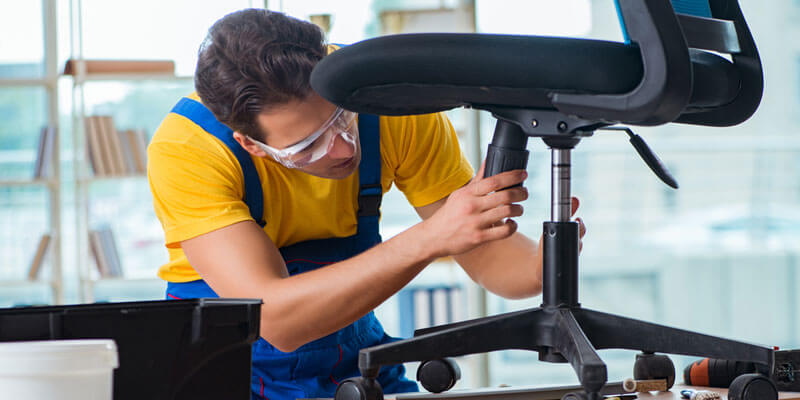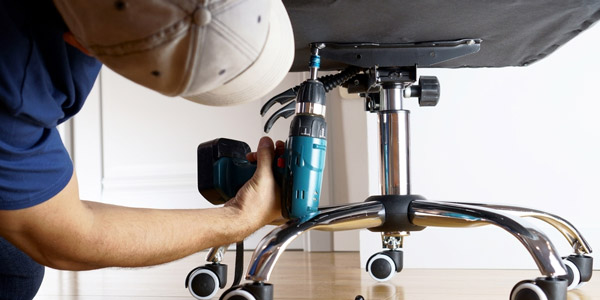After months or years of using an office chair, it’s common for you to hear ear-shattering squeaks every time you lean back. Let’s admit it ーit’s one of the most annoying sounds and puts us in an awkward position in our workplace.

If you sit in your chair almost all day, then it’s likely that the squeaking noise will start getting to you and ultimately affect your productivity. No one can blame you if this problem tires you out and you choose to replace your squeaky office chair.
But before splurging hundreds of dollars on a new office chair, it’s wise to try some tips and tricks and see if the problem goes away.
Thus, this post will cover why office chairs squeak, what you need, and how to fix squeaky office chairs.
Why Is My Office Chair So Squeaky?
There are a couple of reasons your office chair might be making that squeaking noise.

Therefore, it’s essential to understand the underlying cause before trying out any solution to avoid wasting your time and effort.
Once you can pinpoint the noise source, fixing your squeaky chair should be easy. Usually, the underlying cause of this problem is:
- Loose legs
- The sitter’s weight
- Misplace springs
- Rusty parts
- Loosened screws
- Faulty chair wheels
Identifying the Squeaky Part
The best way to figure out the faulty part is to understand your chair’s components and mechanism. Your chair will only make a noise because it’s moving. Therefore, you should try finding the source of the exasperating noise as you move the chair. The spring might be tense, causing the chair to make noise whenever you lean back. If the springs are not at fault, you should check the wheels, the screws, or the rusty parts.
What you’ll need:
As it crops up, you don’t need any fancy or sophisticated tool to solve the squeaking sound. With a screwdriver and lubricant, you should be able to resolve this off-putting problem.
How to Fix Squeaky Office Chair: Step-by-step Guide!
Now that you know the causes of the squeaking sound, let’s dive into how to improve your noisy computer chair.

Check for Rust
Ergonomic office chairs are made of a wide range of materials from steel to wood, plastic, and fabric. Modern chairs, however, feature PVC or vinyl pipes as well as other essential materials.
The swivel base houses several essential parts such as the pneumatic cylinder, tilt adjuster, casters, seat tension, spring, and in some products, the arm. Most of these components are made of metal or steel. Hence, it’s typical for them to rust after a while. When rust accumulates, it makes rotatable components such as the spring squeak.
If you notice rusting, it’s best to scrape it off with a toothbrush and apply oil or lubricant. Be cautious when using these tools to prevent damaging the rusty parts. Suppose the rust is challenging to clean; in that case, you should soak the rusty metal parts in a mixture of white vinegar with salt before scraping the rust off with either a metal brush or a ball of steel wool.
Replace any Rusted Parts
Purchasing a new ergonomic office chair might not be necessary; you can easily change out the rusty parts. Getting these new parts should not be a challenge. In some cases, soaking rusty parts in vinegar might prove ineffective; it’s time to get a new part from your local hardware store. If you can’t find them at a hardware store, you should request the spare parts from the office chair’s seller.
Tighten Bolts & Screws
It’s easy to overlook the screws since they are tiny parts of your squeaky office chair.
However, they are likely the culprit of the exasperating noise. Loose bolts and screws mean the chair’s components are not securely held in place, making it unsafe to sit in.
Therefore, you should check for loose bolts and screws and tighten them immediately. To do this, all you need is a screwdriver. Also, you might check the package to see if the manufacturer or seller included a tool for this purpose.
Lubricate the Metal Parts
Once you scrape off the rusty parts, you want to lubricate the springs and other moving parts to prevent erraticness as you lean. We recommend using spray lubricant because it is easier to use and likely to produce the best result.
Do not forget to apply the oil or lubricant to loose nuts and other components crucial to its movement. While doing this, it’s typical for lubricant or oil to be excessive. It would help if you used a paper towel or tissue to ward the excesses off in this situation.
After adequately polishing the suspected chair components and building the ergonomic office chair back, it’s best to sit, lean, and roll to check for those squeaking noises.
Apply Glue
If a broken part seems to cause that irk noise, you need to use glue to fix it. While the semi-broken armchair might not cause a loud, distracting noise, its sharp edges, if ignored, pose a danger to you.
It’s best to fix this problem with a powerful adhesive such as wood glue to guarantee the broken parts are securely glued together.
Apply Wood-Swelling Glue
This is another type of glue meant for joining wood materials. Therefore, you want to use wood-swelling glue to fix loose or broken wood parts.
More importantly, you want to ensure the wood-swelling glue penetrates the correct spots for the best results. Once it expands the wood fibers, the adhesive guarantees a squeak-free seal.
Fix Faulty Tension Spring
The seat-tension springs act as a seat cushion, usually the culprit when you hear squeaky noise as you lean back.
To fix the springs, you should remove the seat’s fabric and check if the springs are not in place. For broken metal brackets, remove them with cutting pliers and replace them with a new coil or spring to their original position.
But for a webbing system holding the coils together, it’s best to replace the entire system with a webbing stretcher. Afterward, you can return the fabric and ensure it’s well stretched before stapling it on the seat frame.
Examine the Wheel
Office chair wheels are attached to the metal parts, which, with time, will get loose and wear out. The squeaking sound might be coming from friction from the wheel axle. In this case, applying a silicone spray to the metal post and wheel axle should solve the problem.
Furthermore, you want to check the caster wheels if you hear a squeaking noise when you swivel. If any of them is damaged, it’s best to remove them and install a new one.
Replace the chair
This should be the last resort. You should consider purchasing a brand new ergonomic chair only if you’ve tried all options without any decent result or not looking to go through the hassle of repairing a chair.
Also, some components might have been beaten up from wear and tear, which leaves you with few options replace the worn-out parts or purchase a new chair.
In addition, if your office chair is more than five years old, you want to stop trying to fix it and purchase a new one. Although your cranky old ergonomic chair might not make a noise, it’s likely to deliver short on support and comfort.
So, if your modern office chair is overdue and the squeak problem persists, purchasing a new one is the best way to go.
Related FAQ
A creaking office chair can be improved by tightening loose screws or bolts around the front wheels. Also, the friction between your chair’s caster wheels and the floor might cause irritating noise. Hence, it would be best to consider placing a rug under the chair to prevent unwanted movement or sound. Also, if the wheels are broken, replace them.
The best way to restore your ergonomic chair is to apply a lubricant like your household WD40 to the stiff or squeaky parts. Oiling or lubricating these stiff parts pivotal to its movement should solve the problem.
If you hear a clicking noise, check the gas spring and see whether it’s too tight or loose. Also, the bracket might be holding your wheel too tight, causing it to make noise. Thus, it would help if you loosened the faulty bracket.
Conclusion
With many options discussed in this post, it’s easier to assume that fixing your squeaky office chair is exhausting and time-consuming. However, that’s not the case. It’s an easy process, which involves screwing and lubricating rusty parts.
Hopefully, our guide on how to fix a squeaky office chair will help you improve your chair performance and silence the noise. If nothing works, then replacing your ergonomic chair is the only option.
Related Post:
